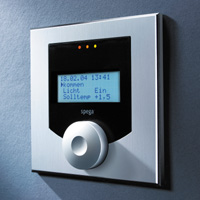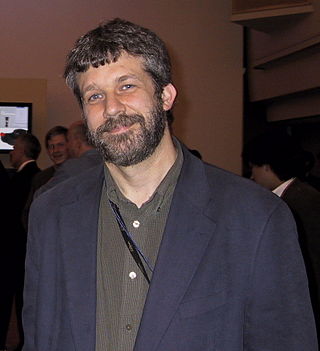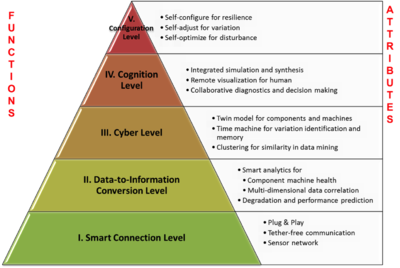Ubiquitous computing is a concept in software engineering, hardware engineering and computer science where computing is made to appear anytime and everywhere. In contrast to desktop computing, ubiquitous computing can occur using any device, in any location, and in any format. A user interacts with the computer, which can exist in many different forms, including laptop computers, tablets, smart phones and terminals in everyday objects such as a refrigerator or a pair of glasses. The underlying technologies to support ubiquitous computing include Internet, advanced middleware, operating system, mobile code, sensors, microprocessors, new I/O and user interfaces, computer networks, mobile protocols, location and positioning, and new materials.

Home automation or domotics is building automation for a home. A home automation system will monitor and/or control home attributes such as lighting, climate, entertainment systems, and appliances. It may also include home security such as access control and alarm systems.

Swarm robotics is an approach to the coordination of multiple robots as a system which consist of large numbers of mostly simple physical robots. ″In a robot swarm, the collective behavior of the robots results from local interactions between the robots and between the robots and the environment in which they act.″ It is supposed that a desired collective behavior emerges from the interactions between the robots and interactions of robots with the environment. This approach emerged on the field of artificial swarm intelligence, as well as the biological studies of insects, ants and other fields in nature, where swarm behaviour occurs.
Wireless sensor networks (WSNs) refer to networks of spatially dispersed and dedicated sensors that monitor and record the physical conditions of the environment and forward the collected data to a central location. WSNs can measure environmental conditions such as temperature, sound, pollution levels, humidity and wind.

A mobile robot is an automatic machine that is capable of locomotion. Mobile robotics is usually considered to be a subfield of robotics and information engineering.

Charlie Catlett is a senior computer scientist at Argonne National Laboratory and a visiting senior fellow at the Mansueto Institute for Urban Innovation at the University of Chicago. From 2020 to 2022 he was a senior research scientist at the University of Illinois Discovery Partners Institute. He was previously a senior computer scientist at Argonne National Laboratory and a senior fellow in the Computation Institute, a joint institute of Argonne National Laboratory and The University of Chicago, and a senior fellow at the University of Chicago's Harris School of Public Policy.

Edge computing is a distributed computing paradigm that brings computation and data storage closer to the sources of data. This is expected to improve response times and save bandwidth. Edge computing is an architecture rather than a specific technology, and a topology- and location-sensitive form of distributed computing.
The Internet of things (IoT) describes physical objects with sensors, processing ability, software and other technologies that connect and exchange data with other devices and systems over the Internet or other communications networks. Internet of things has been considered a misnomer because devices do not need to be connected to the public internet, they only need to be connected to a network, and be individually addressable.
The Advanced Learning and Research Institute (ALaRI), a faculty of informatics, was established in 1999 at the University of Lugano to promote research and education in embedded systems. The Faculty of Informatics within very few years has become one of the Switzerland major destinations for teaching and research, ranking third after the two Federal Institutes of Technology, Zurich and Lausanne.
A sensor grid integrates wireless sensor networks with grid computing concepts to enable real-time data collection and the sharing of computational and storage resources for sensor data processing and management. It is an enabling technology for building large-scale infrastructures, integrating heterogeneous sensor, data and computational resources deployed over a wide area, to undertake complicated surveillance tasks such as environmental monitoring.
A networked control system (NCS) is a control system wherein the control loops are closed through a communication network. The defining feature of an NCS is that control and feedback signals are exchanged among the system's components in the form of information packages through a network.

The Fourth Industrial Revolution, 4IR, or Industry 4.0, conceptualises rapid change to technology, industries, and societal patterns and processes in the 21st century due to increasing interconnectivity and smart automation. The term was popularised in 2015 by Klaus Schwab, the World Economic Forum founder and executive chairman, and has since been used in numerous economic, political, and scientific articles in reference to the current era of emerging high technology. Schwab asserts that the changes seen are more than just improvements to efficiency, but express a significant shift in industrial capitalism.
Fog computing or fog networking, also known as fogging, is an architecture that uses edge devices to carry out a substantial amount of computation, storage, and communication locally and routed over the Internet backbone.
Cloud robotics is a field of robotics that attempts to invoke cloud technologies such as cloud computing, cloud storage, and other Internet technologies centered on the benefits of converged infrastructure and shared services for robotics. When connected to the cloud, robots can benefit from the powerful computation, storage, and communication resources of modern data center in the cloud, which can process and share information from various robots or agent. Humans can also delegate tasks to robots remotely through networks. Cloud computing technologies enable robot systems to be endowed with powerful capability whilst reducing costs through cloud technologies. Thus, it is possible to build lightweight, low-cost, smarter robots with an intelligent "brain" in the cloud. The "brain" consists of data center, knowledge base, task planners, deep learning, information processing, environment models, communication support, etc.
Robot as a service or robotics as a service (RaaS) is a cloud computing unit that facilitates the seamless integration of robot and embedded devices into Web and cloud computing environment. In terms of service-oriented architecture (SOA), a RaaS unit includes services for performing functionality, a service directory for discovery and publishing, and service clients for user's direct access. The current RaaS implementation facilitates SOAP and RESTful communications between RaaS units and the other cloud computing units. Hardware support and standards are available to support RaaS implementation. Devices Profile for Web Services (DPWS) defines implementation constraints to enable secure Web Service messaging, discovery, description, and eventing on resource-constrained devices between Web services and devices.

Smart manufacturing is a broad category of manufacturing that employs computer-integrated manufacturing, high levels of adaptability and rapid design changes, digital information technology, and more flexible technical workforce training. Other goals sometimes include fast changes in production levels based on demand, optimization of the supply chain, efficient production and recyclability. In this concept, as smart factory has interoperable systems, multi-scale dynamic modelling and simulation, intelligent automation, strong cyber security, and networked sensors.
Collaborative Control Theory (CCT) is a collection of principles and models for supporting the effective design of collaborative e-Work systems. Beyond human collaboration, advances in information and communications technologies, artificial intelligence, multi-agent systems, and cyber physical systems have enabled cyber-supported collaboration in highly distributed organizations of people, robots, and autonomous systems. The fundamental premise of CCT is: without effective augmented collaboration by cyber support, working in parallel to and in anticipation of human interactions, the potential of emerging activities such as e-Commerce, virtual manufacturing, telerobotics, remote surgery, building automation, smart grids, cyber-physical infrastructure, precision agriculture, and intelligent transportation systems cannot be fully and safely materialized. CCT addresses the challenges and emerging solutions of such cyber-collaborative systems, with emphasis on issues of computer-supported and communication-enabled integration, coordination and augmented collaboration. CCT is composed of eight design principles: (1) Collaboration Requirement Planning (CRP); (2) e-Work Parallelism (EWP); (3) Keep It Simple, System (KISS); (4) Conflict/Error Detection and Prevention (CEDP); (5) Fault Tolerance by Teaming (FTT); (6) Association/Dissociation (AD); (7) Dynamic Lines of Collaboration (DLOC); and (8) Best Matching (BM).

David Atienza Alonso is a Spanish/Swiss scientist in the disciplines of computer and electrical engineering. His research focuses on hardware‐software co‐design and management for energy‐efficient and thermal-aware computing systems, always starting from a system‐level perspective to the actual electronic design. He is a full professor of electrical and computer engineering at the Swiss Federal Institute of Technology in Lausanne (EPFL) and the head of the Embedded Systems Laboratory (ESL). He is an IEEE Fellow (2016), and an ACM Fellow (2022).
The industrial internet of things (IIoT) refers to interconnected sensors, instruments, and other devices networked together with computers' industrial applications, including manufacturing and energy management. This connectivity allows for data collection, exchange, and analysis, potentially facilitating improvements in productivity and efficiency as well as other economic benefits. The IIoT is an evolution of a distributed control system (DCS) that allows for a higher degree of automation by using cloud computing to refine and optimize the process controls.
Internet of vehicles (IoV) is a network of vehicles equipped with sensors, software, and the technologies that mediate between these with the aim of connecting & exchanging data over the Internet according to agreed standards. IoV evolved from Vehicular Ad Hoc Networks and is expected to ultimately evolve into an "Internet of autonomous vehicles". It is expected that IoV will be one of the enablers for an autonomous, connected, electric, and shared (ACES) Future Mobility.








